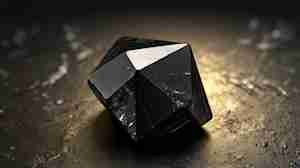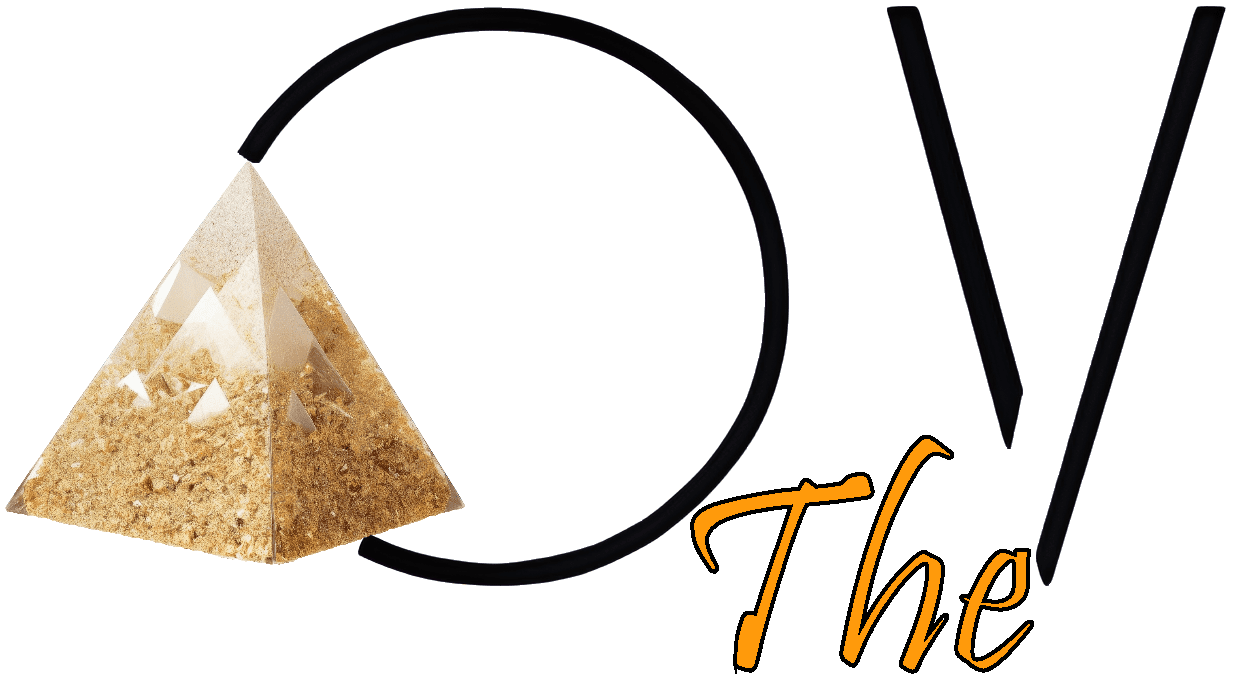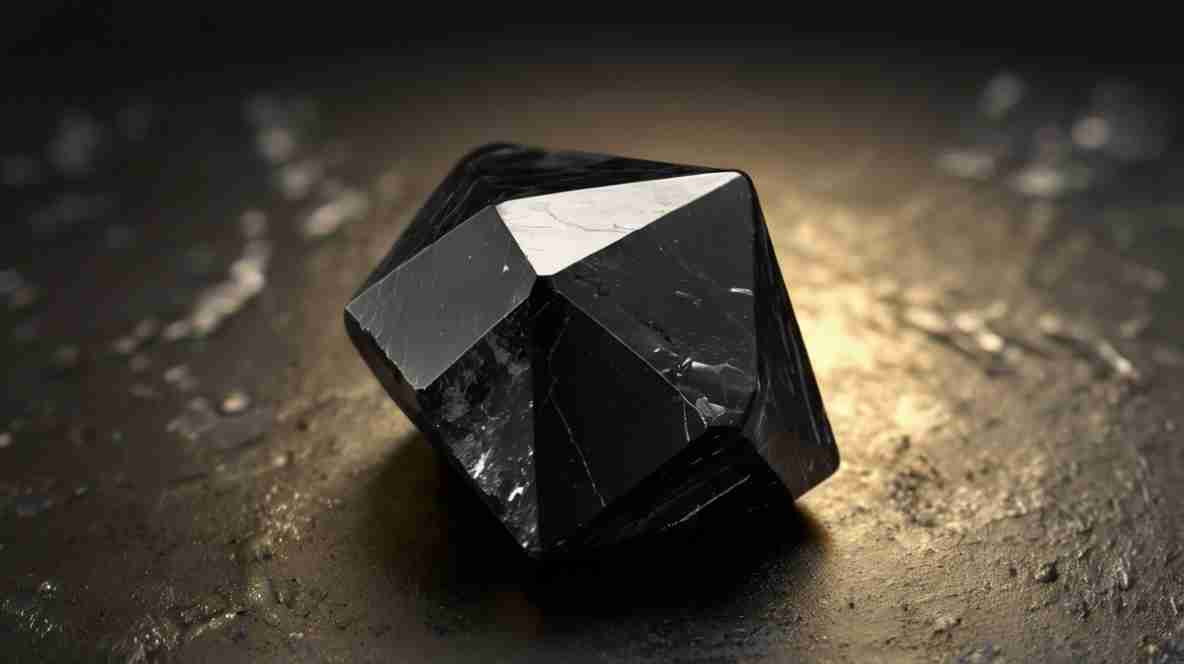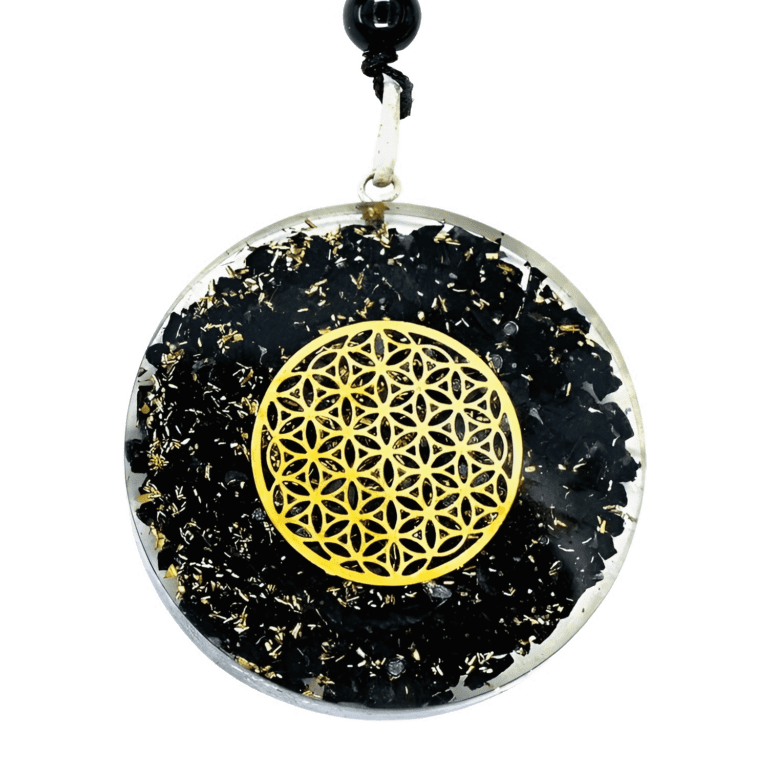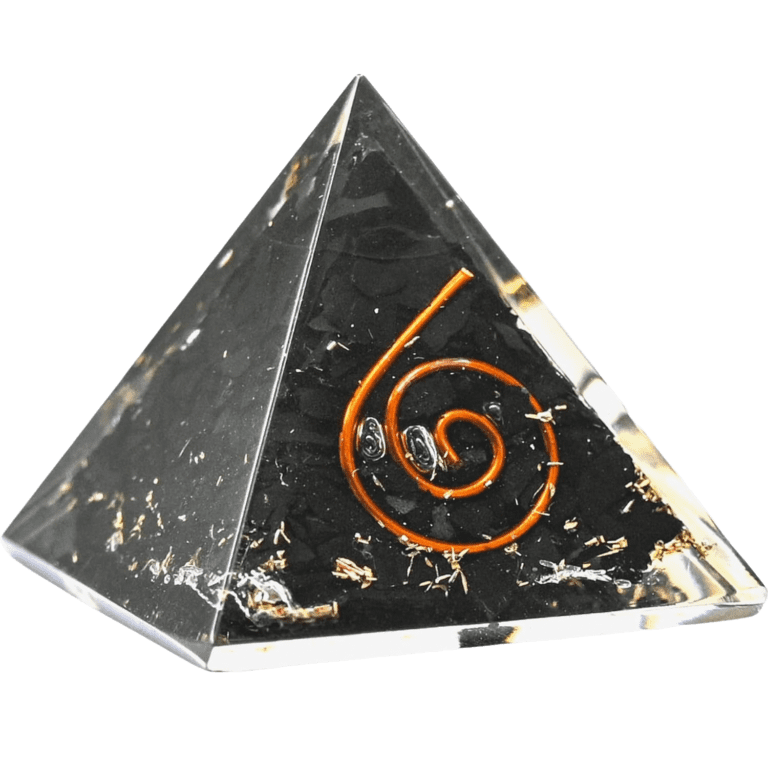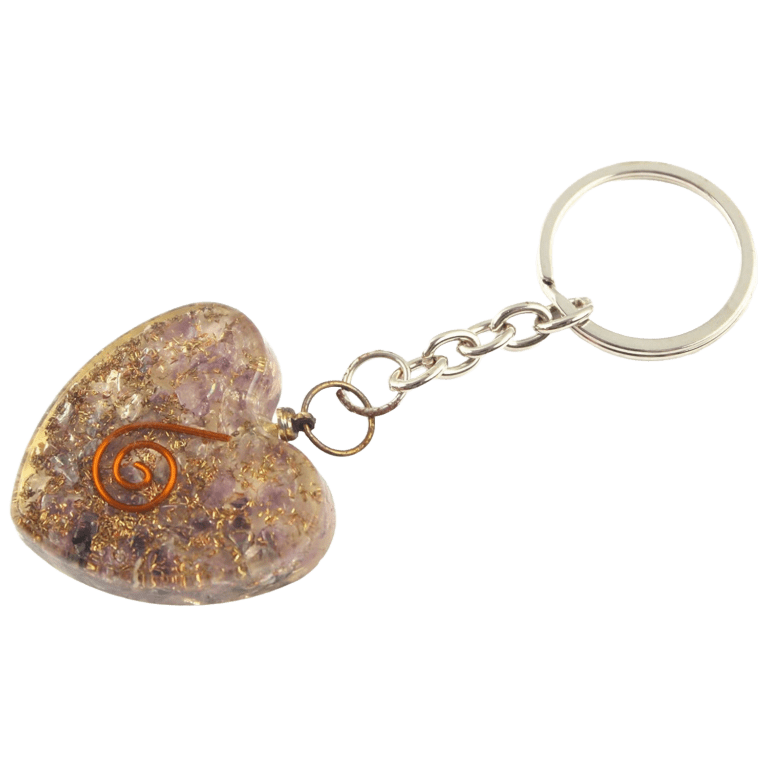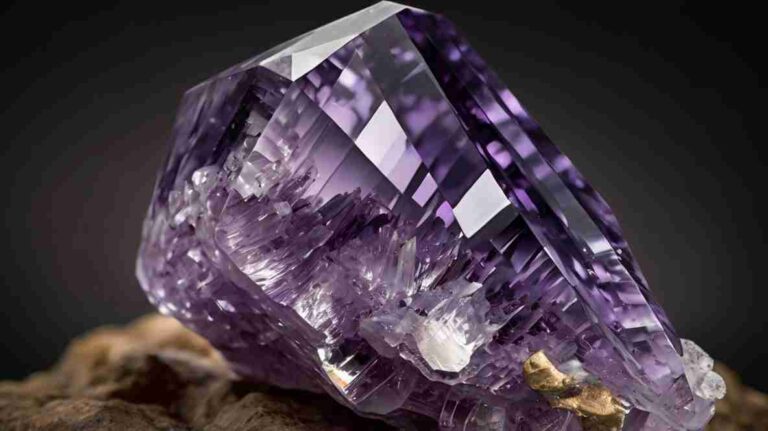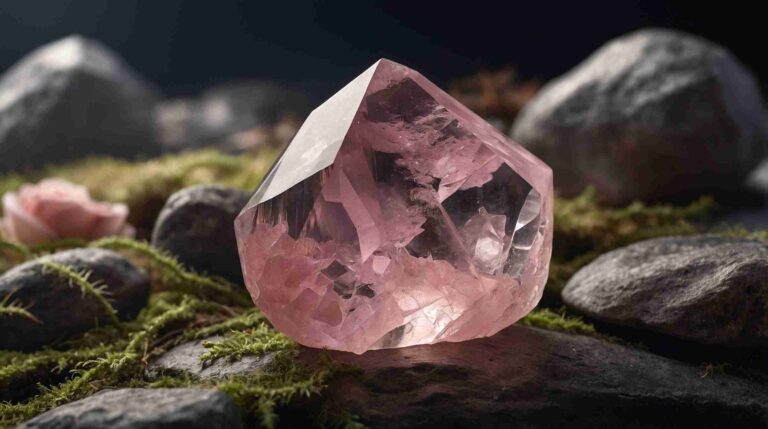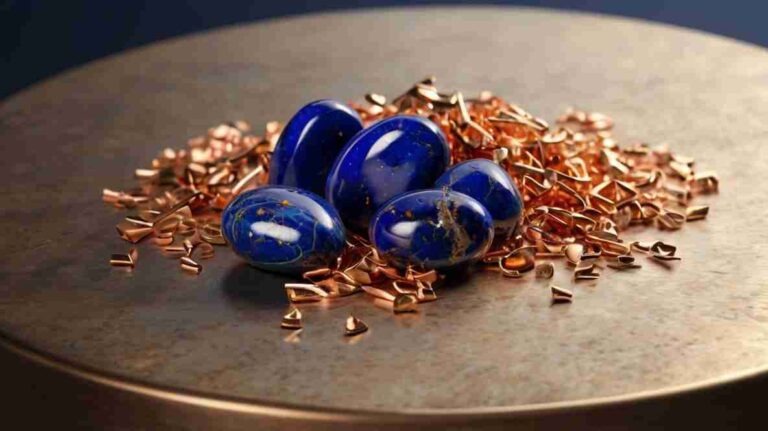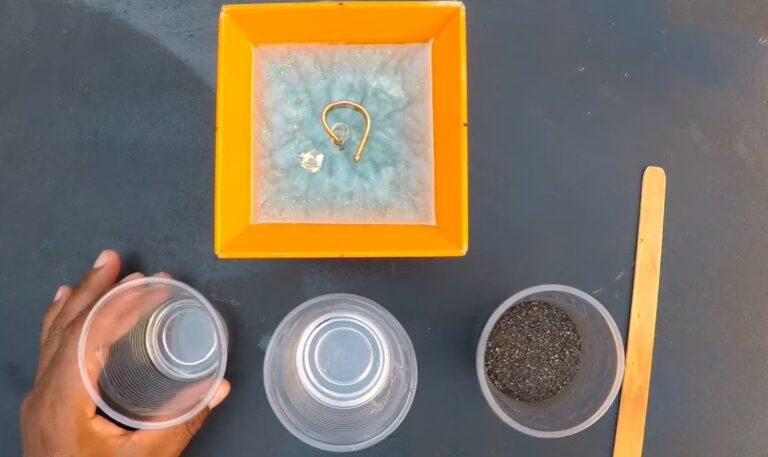Welcome to our exploration of an enigmatic rock with remarkable properties: shungite. Read on to uncover its unique origins, as well as its various uses and benefits.
WHAT IS SHUNGITE?
Shungite, also called Carbon Black, is a mixture of metamorphic rocks that date back to the Precambrian period and are made up of more than 98% organic matter, specifically pyrobitumen, a type of organic matter, formed over millions of years, and which is similar to asphalt but insoluble in organic solvents.
This type of rock can be found in various parts of Russia, being the area of Lake Onega, in the region of Karelia, where it is found in greatest quantities. There are other less significant deposits in Austria, India, the Democratic Republic of Congo and Kazakhstan.

A very special point about this rock is that small concentrations of fullerenes have been detected inside (between 0.0001 and 0.001%). Fullerenes, discovered in 1985, are molecules composed of several carbon atoms organized in the shape of a pentagon or hexagon. These molecular groups of carbon pentagons and hexagons are organized in the form of spheres (known as buckyspheres), or in the shape of a cylinder (giving rise to the famous carbon nanotubes). Along with diamond and graphite, fullerenes are the third stable form of carbon organization. The importance of these compounds lies in the fact that they could open the door to great advances in the field of materials technology in the future.
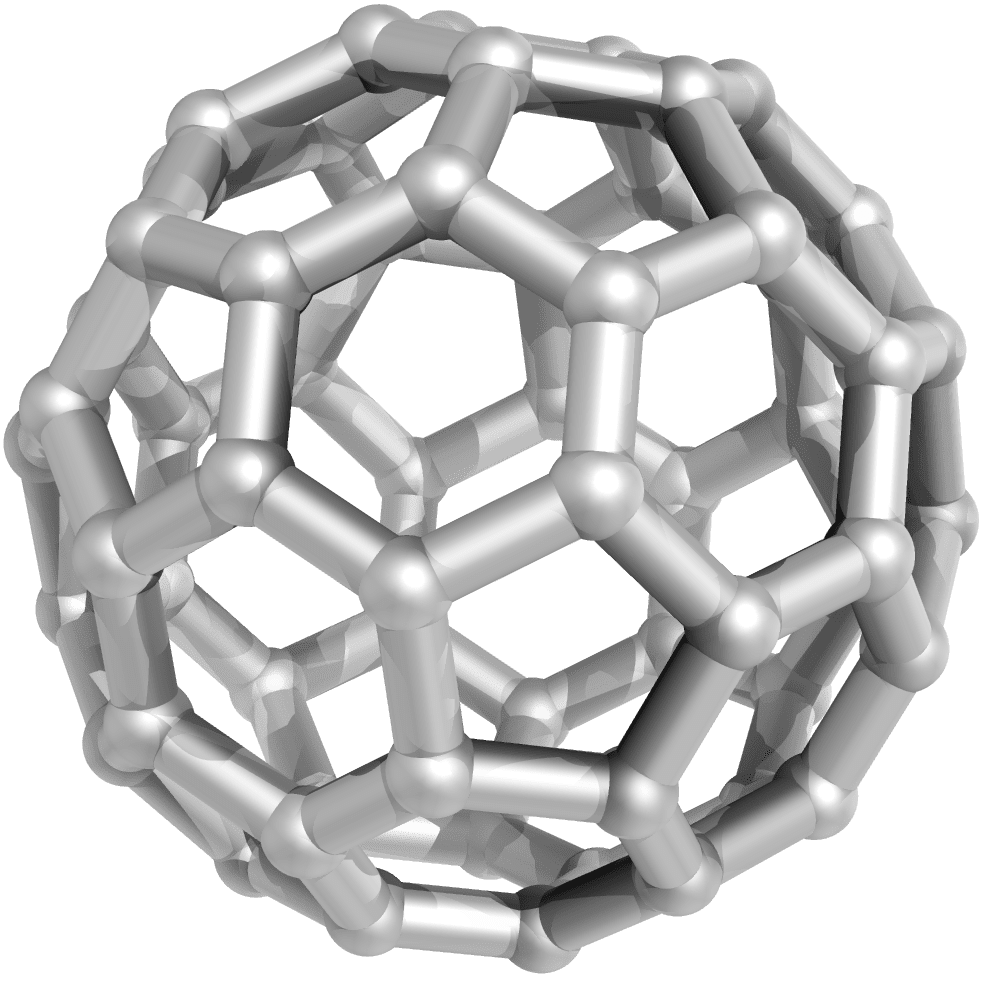
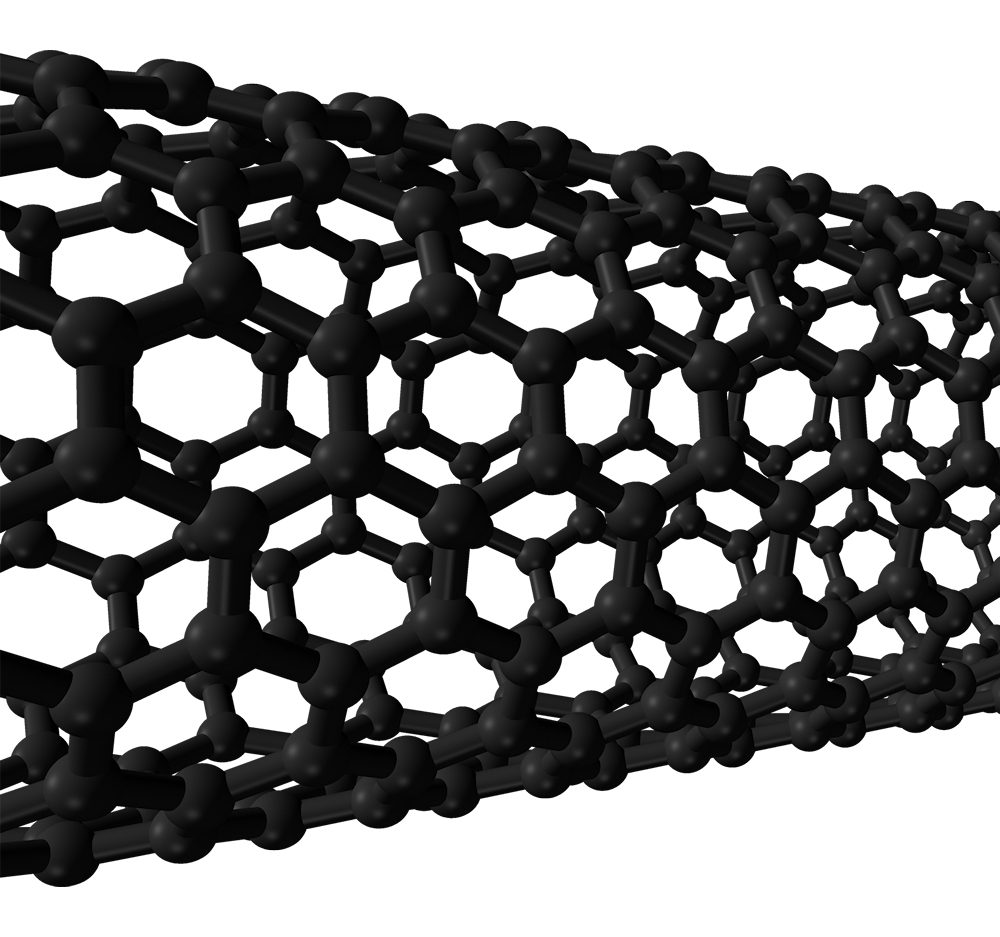
TYPES OF SHUNGITE
Shungite is classified based on its carbon content, distinguishing the following types:
SHUNGITE I – NOBLE ELITE VARIETY
This form comes with a carbon content of between 90 and 98%, showing high electrical conductivity values (1500 mho/m). Has a silvery shine and a fragile surface that chips easily, so is not possible to polish it. It is also the one with the highest percentage of fullerenes in its composition, reaching values of almost 0.001%. Being the rarest (less than 1% of all the varieties found) and purest form, is also the one which reach higher prices in the market. It is the most used in wastewater purification processes. Of all the types, it is the one that has the greatest protection capacity against EMF radiation.
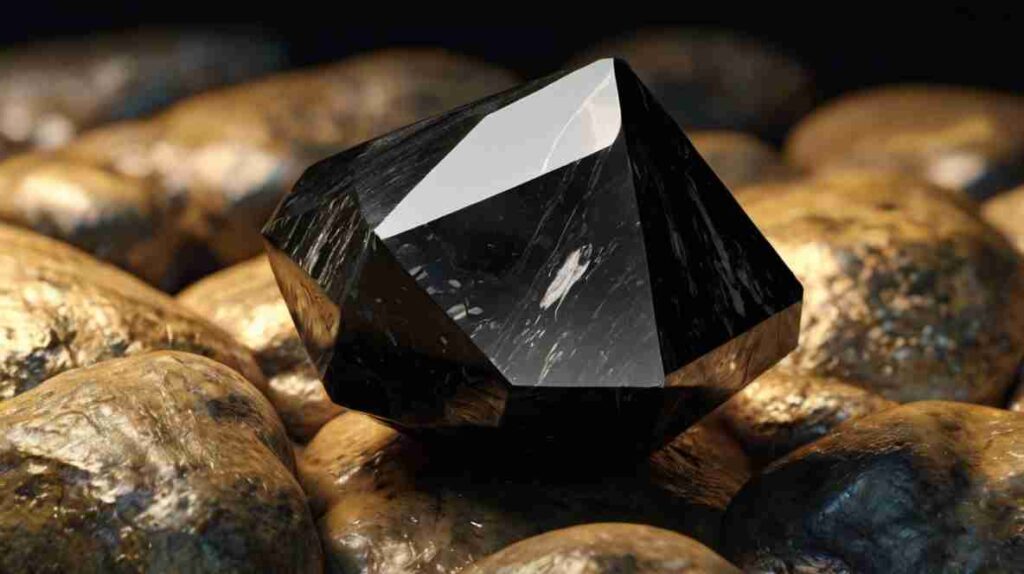
SHUNGITE II – RAW VARIETY OR PETROVSKY SHUNGITE
Shungite II, also called Petrovsky Shungite, is a variety with a carbon content that ranges from 35% to 80%. It is the best of the varieties in terms of quality/price ratio, since it is much cheaper than type I while maintaining many of its properties, especially its abilities to block EMF radiation. On the other hand, it is much less fragile than the previous variety, therefore it can also be polished.
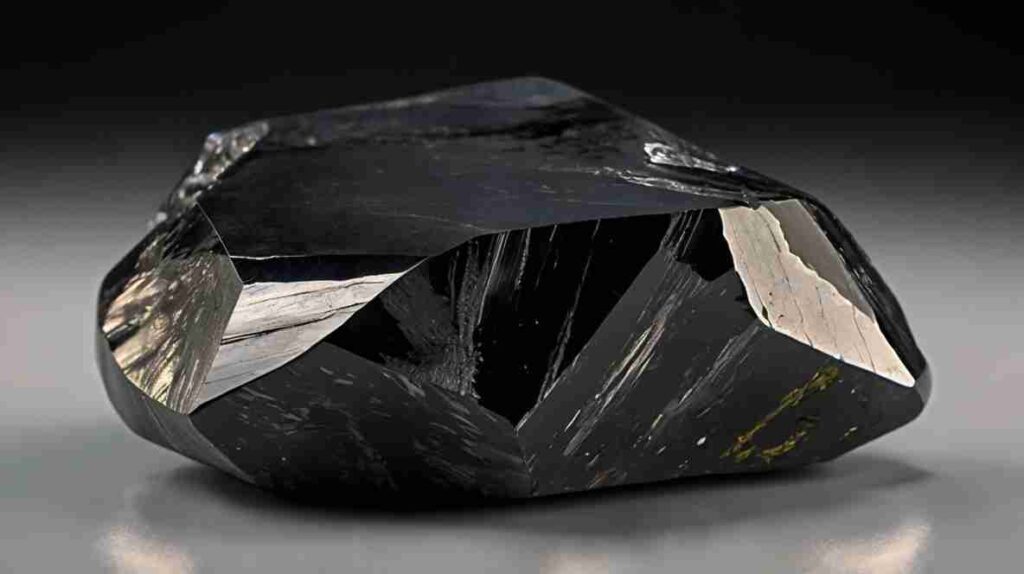
SHUNGITE III, SHUNGITE IV AND SHUNGITE V – REGULAR SHUNGITES
At this point we find a wide variety of shungites with carbon percentages ranging from 20% to 35% for type III, from 10% to 20% for type IV, and less than 10% for type V. They are the most economical varieties and all of them can be polished without major problems. They still maintain good properties against EMF radiation and represent the vast majority of shungite that we can find in commercial applications such as orgonites.
An average Regular shungite can cost between 0.10-0.15 usd per gram, although bigger stones can reach proices of 2 usd per gram.
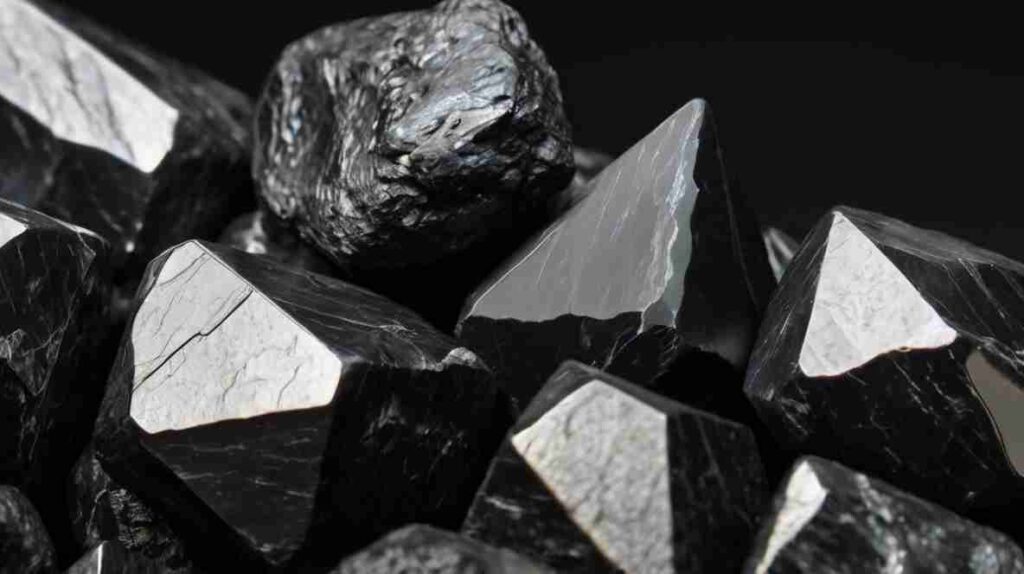
PHYSICAL PROPERTIES
The physical properties can vary depending on the type of rock we are talking about. As we have seen, most of its composition is carbon although there are a lot of other elements present in its structure, being the most common: calcium, silicon, magnesium, and sulfur.
We can say that it is a relatively soft material, with a hardness between 3.5 and 4.0 on the Mohs scale. With its high electrical conductivity, it has also a thermal conductivity of 3.8 W/m.K, and is a relatively dense stone with a density of 2.1 to 2.4 gr/cm3. Its molecules are strongly polar and some stone varieties can have magnetic properties.
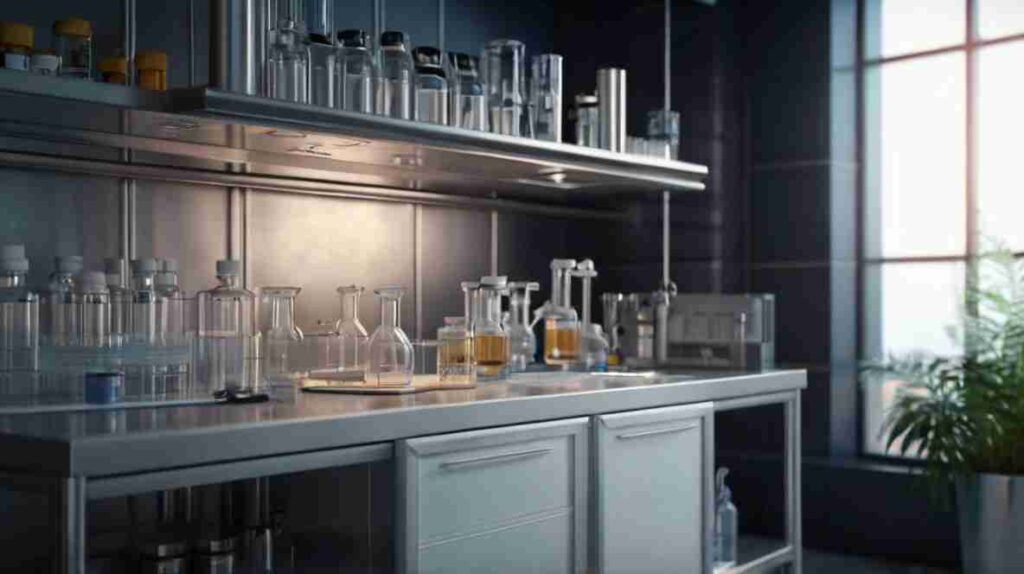
DIFFERENCES WITH OTHER COMMON MATERIALS
Due to its black color and characteristic appearance, it is very common to confuse shungite stones with other materials. The first question we could ask ourselves is whether shungite and coal are the same thing. The answer is positive, although with nuances. We can say that shungite is a type of carbon, similar to anthracite, although in some cases it can be denser. In fact, morphologically it would be between anthracite and graphite.
Another second source of confusion, seeing its appearance, is whether it is a meteorite. Nothing could be further from the truth: shungite rocks are formed in the bowels of the Earth, over millions of years, and, like coal and oil, are formed by the compression of organic matter from animals and plants that lived millions of years ago. Therefore, its resemblance to a meteorite is merely visual since its origins have nothing to do with it.
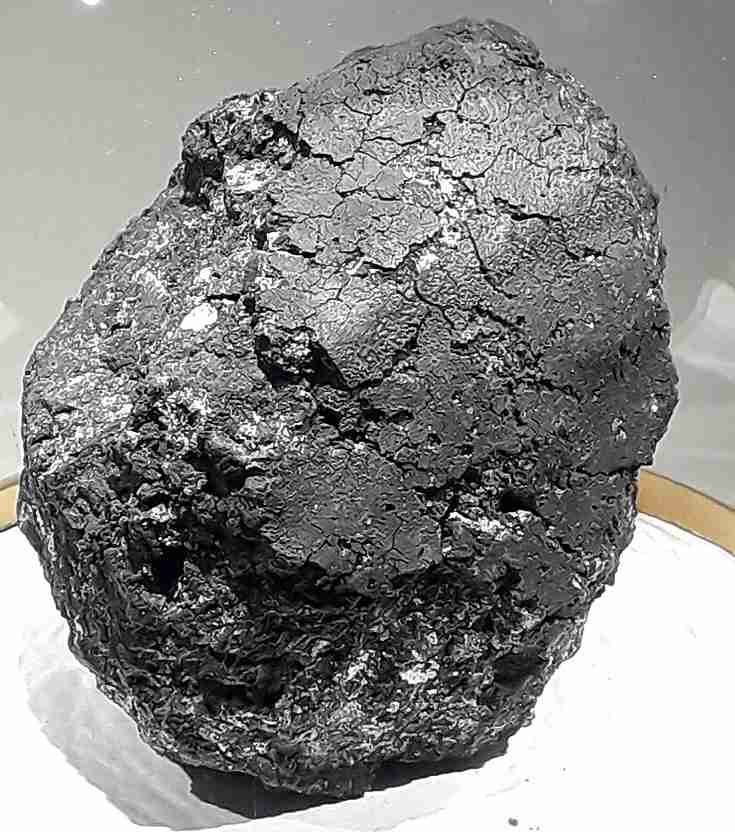
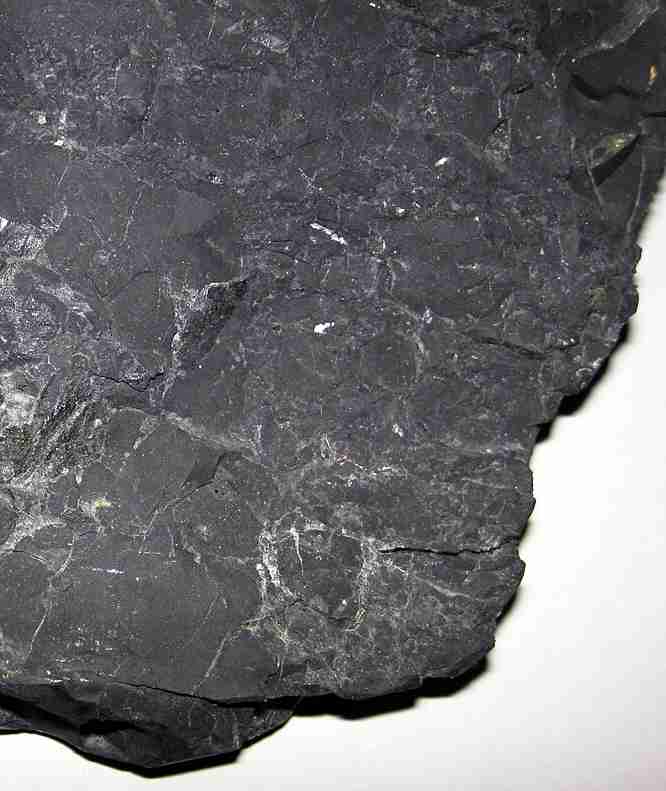
Some people also confuse it with hematite. It is another very common mistake, since hematite is a heavy and quite hard mineral formed by iron oxide. Again it has nothing to do with shungite.
Another point that may come to mind given the resemblance with other minerals is whether it is the same as obsidian or black tourmaline.
Shungite and obsidian have nothing in common. As we have seen, shungite is a stone formed mostly by carbon in processes similar to those that give rise to the formation of coal or oil. Obsidian, on the other hand, is a volcanic rock formed by silicon, similar to glass, used by pre-Columbian cultures to make staves and spears precisely because it is an extremely sharp material.
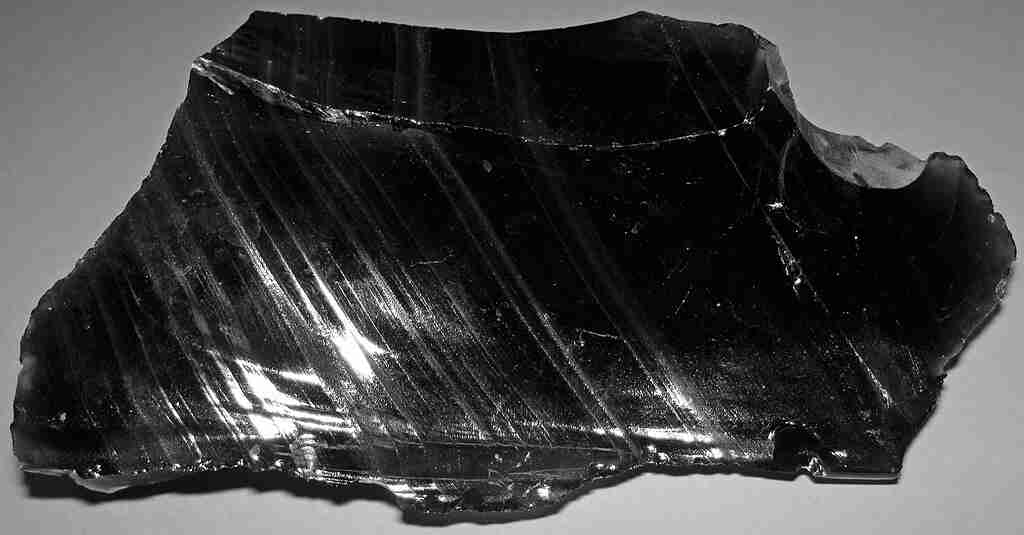
The same happens with black tourmaline, a silicate mineral that has nothing to do with shungite and its carbonaceous structure.
Therefore, despite sharing color and general appearance, shungite stone is neither volcanic nor similar to obsidian, black tourmaline, or hematite. Its only similarity is with coal.
Given that shungite can closely resemble other stones and materials, it’s important to be cautious of counterfeit varieties. Here is a video that will assist you in verifying the authenticity of your stone.
INDUSTRIAL USES
Due to its structure and its physical and chemical properties, shungite has a series of industrial uses that are discussed below.
WATER PURIFICATION SYSTEMS
Shungite has ability to effectively filter water stems from its intricate network of pores, which provide a large surface area for adsorption. This allows shungite to capture and retain contaminants, including organic molecules, chlorine, pesticides, and heavy metals, thereby improving water quality. The filtration efficiency of the mineral is enhanced by its durability and resistance to degradation, ensuring long-term performance in water treatment applications.
In addition to physical filtration, shungite exhibits adsorptive properties that facilitate the removal of dissolved impurities from water. The mineral’s surface contains active sites capable of attracting and binding contaminants through chemical interactions. Its absorbing capabilities are close to 20m2/g. Furthermore, shungite’s ion exchange capacity enables it to remove toxic ions, such as lead, cadmium, and arsenic, by replacing them with less harmful ions present in the surrounding environment.

Beyond filtration and adsorption, shungite possesses inherent antibacterial properties that contribute to water disinfection. Studies have shown that can inhibit the growth of bacteria, viruses, and other microorganisms, making it an effective tool for combating waterborne diseases. This natural antibacterial action reduces the need for chemical disinfectants, thereby minimizing environmental impact and preserving water quality.
For all that reasons, is widely used for treating drinking water. However, there’s a caveat: While it effectively removes contaminants, it also releases various chemical elements into the water, including heavy metals like nickel, copper, lead, cadmium, zinc, chromium, and arsenic. Therefore, proper washing of shungite are essential before using it in drinking water systems.
Finally, water treated with shungite has an acidic pH that can reach up to 3.5. That is why it must be subsequently neutralized to increase the pH to normal drinking values close to 7. If you drink water treated with the rock before the neutralization process, the taste will be sour, spicy and metallic.
SHUNGITE AS A CONSTRUCTION MATERIAL
In the 1970s, shungite was utilized in creating an insulating material known as shungisite, which is prepared by heating rocks with low shungite concentrations to temperatures ranging from 1,090°C to 1,130°C (1,990°F to 2,070°F).
This kind of shungite-based additives make them excellent candidates for enhancing fire resistance and thermal insulation in construction materials at the same time that act as a low density fillers. Shungite-based additives can also inhibit the spread of flames and reduce smoke emissions in the event of a fire. Furthermore, the high thermal conductivity of shungite enables it to dissipate heat efficiently, making it suitable for applications in passive fire protection and energy-efficient building designs.

PIGMENT FOR PAINT INDUSTRY
Since the 18th century, shungite has been utilized as a pigment for paint, and today is still marketed under the denomination of “carbon black”
Shungite imparts a deep, rich black hue to formulations, offering a natural alternative to synthetic dyes and pigments. Its color intensity and stability make it well-suited for applications where vibrant, long-lasting coloration is desired, being really appreciated by artists due to the richness and depth that adds to their creations.

BENEFITS AND HEALING PROPERTIES
Given its carbon-rich composition and the existence of fullerenes in its molecular structure, its beneficial properties are very broad and it is increasingly being investigated for its use in different fields.
SHUNGITE AS ANTI-INFLAMMATORY FOR THE SKIN
Is shungite good for the skin? One of the effects that is being investigated is its use as an anti-inflammatory for the skin. In studies done in mice the researchers explored the in vivo effects of shungite against UVB-induced skin damage by investigating physiological skin parameters, immune-redox profiling, and oxidative stress molecular signaling. Hairless mice were UVB-irradiated for two consecutive days, followed by topical application of shungite on their dorsal skin for 7 days. The key findings were:
- The shungite-treated groups showed significant improvements in skin parameters:
- Reduced roughness
- Reduced pigmentation
- Reduced wrinkle measurement
- Immunokine profiling in mouse serum and skin lysates revealed a reduction in the proinflammatory response in the shungite-treated groups.
- Shungite-treated groups exhibited a counterbalance of reactive oxygen species (ROS) and reactive nitrogen species (RNS) levels in serum and skin lysates.
The study clearly demonstrated that shungite has anti-inflammatory actions against UVB-induced skin damage in hairless mice.
References:
Antioxidant and Anti-Inflammatory Effects of Shungite against Ultraviolet B Irradiation-Induced Skin Damage in Hairless Mice. Ma. Easter Joy Sajo, Cheol Su Kim, Soo-Ki Kim, Kwang Yong Shim, Tae-Young Kang, and Kyu-Jae Lee
ANTI-BACTERIAL PROPERTIES
The study of the bactericidal properties of shungite is another field that is being researched. Its usefulness as a bactericide has been proven against Escherichia coli in two scientific studies. In the first, carried out by the Estonian Academy of Sciences, samples of E. Coli, Pseudomonas aeruginosa, and Streptococcus uberis did not survive 24 hours in a 3:7 shungite water extract. However, some other bacteria and yeasts, like Staphylococcus aureus and Candida albicans, survived to the experiment.
Another study observed that has strong bactericidal properties and efficiently disinfects drinking water from harmful bacteria. Almost complete elimination of E. coli was achieved, reducing cell concentration from 2300 per liter to just 3 per liter.
References:
Microbiological and chemical properties of shungite water. Silver Türka, Tarmo Tammb, Hugo Mändarc, Ain Raald, Peeter Laursone and Uno Mäeorg
Determination of the biological activity of shungite. T. Shevchenko, Y. Ustinova, G. Uzunov
SHUNGITE AS AN ANTIOXIDANT
Although shungite shows weaker antioxidant activity than other agents such as quercetin, several scientific studies have proven its antioxidant power. Specifically, in a 2021 study, some samples shown a clear antioxidant activity:
- The sample labeled as Sh20 (size fraction—20 μm) demonstrated the highest antioxidant activity according to the amperometric method. It contained:
- Equivalents of 1.30 mg of ascorbic acid per gram of shungite.
- Equivalents of 3.46 mg of trolox (a synthetic antioxidant) per gram of shungite.
- Equivalents of 0.99 mg of quercetin (a natural antioxidant) per gram of shungite.
- Another sample, ShT20 (size fraction—20 μm + heat treatment), exhibited the highest antioxidant activity against the 2,2-diphenyl-1-picrylhydrazyl radical (a common free radical used for testing antioxidant capacity) and showed cytotoxicity.
References:
A Study of the Antioxidant, Cytotoxic Activity and Adsorption Properties of Karelian Shungite by Physicochemical Methods. Liubov Skrypnik, Olga Babich, Stanislav Sukhikh, Olga Shishko, Svetlana Ivanova, Oleg Mozhei, Ivan Kochish and Ilia Nikonov
AS A FERTILIZER FOR PLANTS
The use of shungite as a fertilizer for plants is a viable option according to existing scientific studies. In 2021, a research was conducted on Allium cepa (onion) plants to evaluate the effect of its application in Umbric Podzols soils on the mitochondrial respiration pathways of leaves and roots, as well as the leaf response to temperature change.
The experiments were conducted in pots with onion seedlings using mineral concentrations in soil of 0, 5, 10, and 20 g kg-1, along with two soil water regimes: well-watered (WW) and drying-rewetting cycles (DW).
The results showed that shungite application affected the total respiration rate (Vt) of onion leaves only at 13 °C. Under the WW regime, Vt increased, while under the DW regime, it decreased. Shungite application also increased the sensitivity of leaf respiration to the alternative respiratory pathway inhibitor (salicylhydroxamic acid, SHAM) at 33 °C.
The study also demonstrated that shungite application to soil can alter nutrient concentrations in onion seedlings. Depending on the soil water regime, shungite may increase potassium, manganese, zinc, and nickel content in plants, thus affecting certain physiological traits.
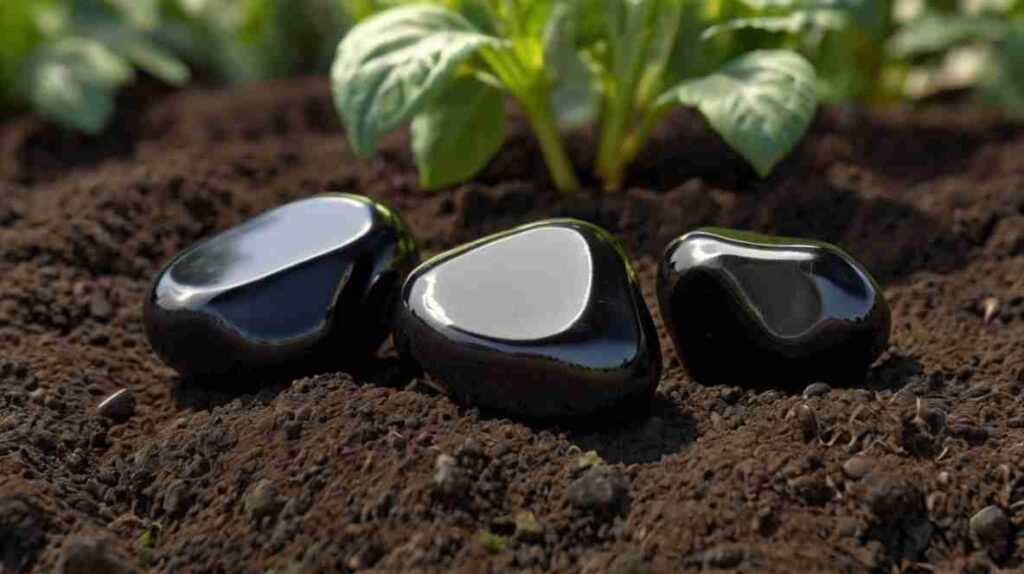
References:
Effect of Shungite Application on the Temperature Sensitivity of Allium cepa Respiration under Two Soil Water Regimes. Elena Ikkonen, Svetlana Chazhengina, Olga Bakhmet andValeria Sidorova.
SHUNGITE AS A PROTECTOR FROM EMF RADIATION
Since the beginning of the Industrial Revolution we have been continually bathed in a type of radiation generated by electromagnetic fields that are produced when electricity is created or used. This type of radiation is released from any electrical lines, appliances, etc. In recent years the dose we receive has worsened due to the emergence of mobile telephony, because we are in constant contact with mobile phones and we even sleep with them.
There are many studies and much controversy about the effects of this type of radiation on people. Although studies continue, it is related to insomnia problems, headaches, memory problems, fatigue, depression, etc.
One of the most promising benefits of shungite is its possible ability to block, transmute, or protect against this type of radiation. Among the existing studies, one carried out in 2003 subjected mice to doses of low-intensity microwave radiation (MWR). Two groups of mice were made, some were shielded with shungite and others were not. All of them received radiation for 15 minutes, and radiation with different polarization planes was even tested. Subsequently, a complete blood test was performed on all specimens, measuring leukocytes, erythrocytes, basophils, lymphocytes, etc. The results clearly indicated that shielding with shungite decreased the severity of damage produced by MWR.
Despite these promising results, more research is needed to find out what level of protection shungite can offer.
References:
Shielding Effect of Mineral Schungite during Electromagnetic Irradiation of Rats. S. P. Kurotchenko, T. I. Subbotina, I. I. Tuktamyshev, I. Sh. Tuktamyshev, A. A. Khadartsev & A. A. Yashin
METAPHYSICAL AND EMOTIONAL PROPERTIES
In addition to the help thatthe rock can provide when it comes to protecting against electromagnetic fields, it is worth reviewing benefits that are attributed to it and are within the metaphysical and emotional field. An important point to consider is that the benefits of shungite, both those studied in previous paragraphs and those that will be seen below, are indifferent to whether the stone is used in a polished or raw form. The effect is the same.
SHUNGITE AS ANXIETY REDUCER
Shungite has traditionally been attributed anxiety and stress reducing properties. While it is true that its capacity is at the level of labradorite or tiger’s eye, it is not at the level of other healing crystals with much higher capacities for this purpose such as amethyst.
SHUNGITE TO OPEN THE CHAKRAS
Although it is not well known because there are more widely used alternatives, shungite, like obsidian, is commonly associated with the Root Chakra. However, it is more common to use, for example, red jasper in chakra opening therapies.
It is normally used in meditation therapies by holding between the extremities an object that contains shungite, such as an orgone pyramid.


SHUNGITE AND ZODIAC
Since shungite offers protection against electromagnetic fields, which are a form of energy, astrologers attribute its abilities to align the energy of all zodiac signs equally.
INCOMPATIBILITIES
There are no incompatibilities to consider regarding healing crystals that should not be used in combination with shungite. On the contrary, it can be combined with carnelian and red jasper to enhance self-confidence, with lapis-lazuli or aquamarine to enhance intuition, or with amethyst to enhance its stress reduction capabilities.
HOW TO USE SHUNGITE?
There are different ways to take advantage of the benefits that shungite can offer.
WEARING SHUNGITE
Perhaps the simplest option of all is to wear a piece that contains the mineral. There are countless options such as pendants, bracelets, etc. If you also combine shungite with the power of orgone energy, the range expands to options such as orgone keychains, small domes, merkabas, etc. Let’s see some cases:
WEARING A SHUNGITE ORGONE PENDANT
This option is quite intriguing as it allows for continuous exploitation of the benefits it provides. If you wear the orgone pendant at night, it will help you fall asleep while protecting you against EMF radiation that may be generated if you leave your phone charging at night.
WEARING A SHUNGITE ORGONE KEYCHAIN
In this case we are not talking so much about wearing a shungite orgonite, but rather about carrying it. In your daily life, carry your cell phone and an a shungite orgone keychain in the same pocket if you want to ensure continuous protection from EMF radiation.
OTHER WAYS TO USE IT
Another popular method of utilizing shungite, particularly within orgonites that include it, is to position it strategically around your home. If you have one or more orgone pyramids, or for example orgone tower busters made of shungite, place them near sources of EMF radiation emission, such as the television, microwave oven, computer, etc.
Another interesting use for a shungite orgonite is to wear it when you are going to catch a plane. When we fly, we are above 30,000 feet and we lose part of the protection that the atmosphere offers us against cosmic rays. Wearing a shungite orgonite can help mitigate the effects that this harmful radiation can have on our health. In addition, being composed mainly of carbon, shungite does not cause any problems in security controls.
